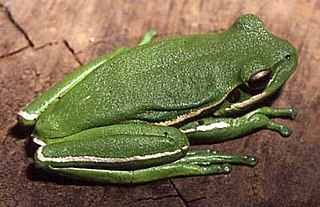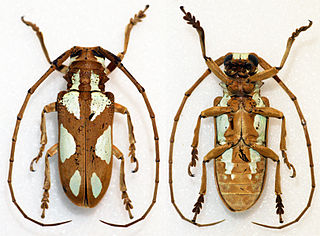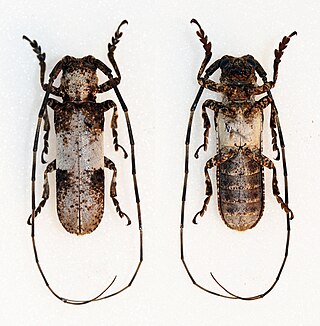
Ahaetulla prasina is a species of snake in the family Colubridae to southern Asia. Its common names include Asian vine snake, Boie's whip snake, Gunther's whip snake, Oriental whip snake,.

Boana prasina is a species of frog in the family Hylidae. It is endemic to Southeastern Brazil and is observed in many Brazilian states: Minas Gerais, Rio de Janeiro, and São Paulo, and possibly further south. The common name of Boana prasina is Burmeister's treefrog.

Anaplectoides prasina is a species of moth of the family Noctuidae. It is found in both the Palearctic and Nearctic realms.

Aeolochroma is a genus of moths in the family Geometridae described by Prout in 1912.

Daljina, dim i prašina is the ninth studio album from Serbian rock band Bajaga i Instruktori, released in 2012.
Aeolochroma prasina is a moth of the family Geometridae first described by William Warren in 1896. It is found on New Guinea and Seram.

Prosopocera is a genus of flat-faced longhorn beetles in the subfamily Lamiinae.

Prosopocera lactator, the Turquoise Longhorn, is a species of flat-faced longhorn beetles in the subfamily Lamiinae.

Prosopocerini is a tribe of longhorn beetles of the subfamily Lamiinae. It was described by Thomson in 1868.

Prosopocera bipunctata is a species of flat-faced longhorn beetles in the subfamily Lamiinae. It was first described by Dru Drury in 1773, from Sierra Leone.
Prosopocera gigantea is a species of beetle in the family Cerambycidae. It was described by Stephan von Breuning in 1950. It is known from Tanzania and Malawi.
Prosopocera belzebuth is a species of beetle in the family Cerambycidae. It was described by James Thomson in 1857. It is known from Nigeria, the Ivory Coast, Togo, Senegal, the Central African Republic, and the Democratic Republic of the Congo.
Prosopocera viridegrisea is a species of beetle in the family Cerambycidae. It was described by Hintz in 1911. It is known from Kenya, the Democratic Republic of the Congo, and Gabon.

Prosopocera callypiga is a species of beetle in the family Cerambycidae. It was described by Thomson in 1857, originally under the genus Ceroplesis. It is known from Tanzania, and possibly South Africa.
Prosopocera fryi is a species of beetle in the family Cerambycidae. It was described by Murray in 1871. It is known from Nigeria and the Democratic Republic of the Congo. It contains the varietas Prosopocera fryi var. ochreomaculata.

Prosopocera myops is a species of beetle in the family Cerambycidae. It was described by Chevrolat in 1855. It is known from Nigeria, the Ivory Coast, the Republic of the Congo, the Democratic Republic of the Congo, and Sierra Leone.
Prosopocera princeps is a species of beetle in the family Cerambycidae. It was described by Frederick William Hope in 1843, originally under the genus Lamia. It is known from the Ivory Coast, Guinea, Gabon, Senegal, and Sierra Leone. It contains the varietas Prosopocera princeps var. ivorensis.

Stenoperla prasina is a species of stonefly belonging to the family Eustheniidae. This species is endemic to New Zealand and is classified as "Not Threatened" under the New Zealand Threat Classification System. It is found on the North, South and Stewart Island / Rakiura Islands as well as on Little Barrier Island. Although adults of this species are most often coloured bright green, this species can be coloured yellow. This species inhabits clean, cold, running streams and rivers with stony bottoms within native bush. It is a known indicator of water quality. The larvae eat plant detritus and other aquatic insects while the adult insects feed on sooty mould fungi as well as other plant matter. The adults of this species are a known food source for New Zealand long tailed bats. Adults have been dissected and have been found to have been carrying Nematomorpha and trematode parasites. The New Zealand Department of Conservation classifies this species as "Not Threatened". In 2022 a specimen of this species was the 5 millionth specimen to be digitised in the Natural History Museum, London collection.
Kostas Chatzimichail is a Greek former footballer who played as a forward and a former manager.











